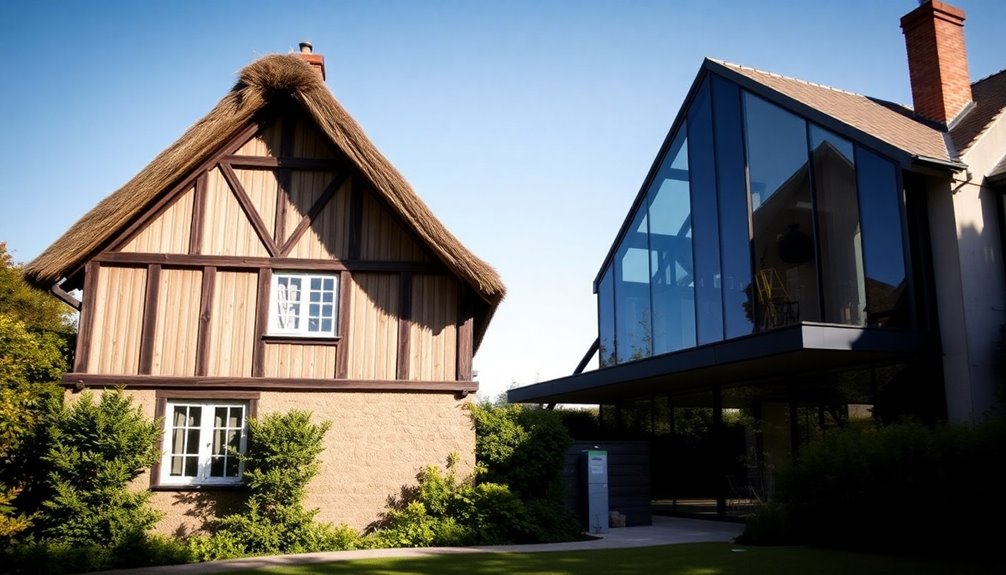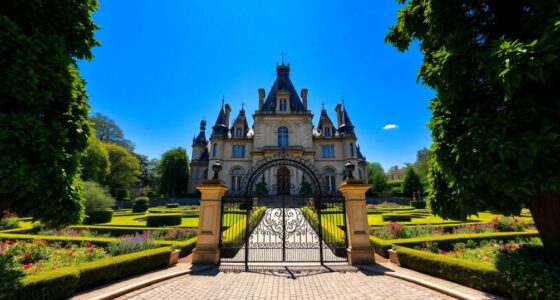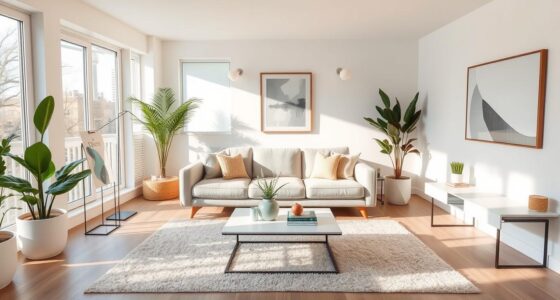Traditional and modern houses showcase distinct characteristics that cater to different preferences. Traditional homes feature intricate designs, sturdy materials, and compartmentalized layouts, creating cozy spaces for gatherings. In contrast, modern homes emphasize minimalism, utilizing industrial materials and open-concept designs for a sleek, functional feel. You'll find that modern houses often incorporate energy-efficient technologies, leading to lower utility bills and a sustainable lifestyle. At the same time, traditional homes tell stories of local heritage and craftsmanship. By understanding these differences, you can decide which style resonates with your values and lifestyle, and explore the nuances further.
Key Takeaways
- Traditional houses feature intricate designs and compartmentalized layouts, while modern homes emphasize minimalism with open-concept spaces and sleek lines.
- Energy efficiency is prioritized in modern architecture through advanced insulation and smart technologies, significantly reducing utility costs compared to traditional homes.
- Traditional homes reflect local history and craftsmanship, fostering community identity, whereas modern designs promote innovation and societal progress.
- Aesthetic preferences differ, with traditional styles appealing to nostalgia through rich textures and craftsmanship, while modern architecture attracts those valuing functionality and sustainability.
- The impact on lifestyle varies, with traditional homes enhancing social interactions and modern houses offering convenience through flexibility and smart home integration.
Overview of Architectural Styles

When you explore architectural styles, you'll notice a fascinating contrast between traditional and modern homes.
Traditional architecture, with its rich history, showcases detailed craftsmanship and styles like Victorian, Colonial, and Craftsman. These homes often use durable materials such as brick, wood, and stone, featuring ornate details and symmetrical designs.
On the other hand, modern architecture emerged in the early 20th century, emphasizing minimalism and functionality. Modern homes utilize materials like glass, steel, and concrete, promoting open-concept layouts that maximize space and light.
One of the key differences lies in energy efficiency; modern designs incorporate smart technology and sustainable systems, aligning with today's focus on convenience and environmental responsibility. Furthermore, the integration of smart bathroom technologies in modern homes enhances comfort and promotes eco-friendly practices.
Each style reflects unique values and aesthetics, giving you plenty to reflect upon.
Features of Traditional Homes
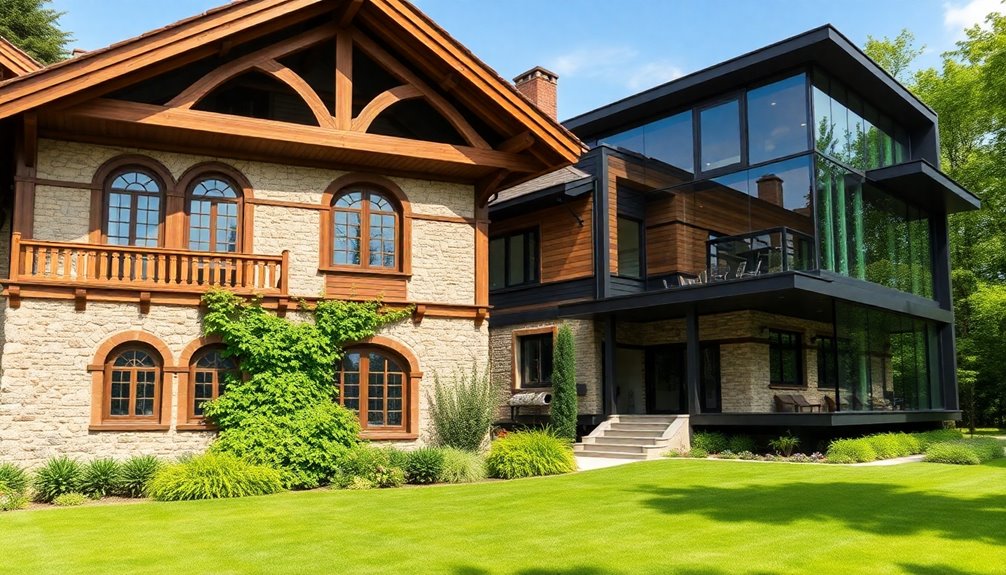
Traditional homes exude charm with their intricate architectural details, such as gabled roofs and inviting front porches. These homes often incorporate durable materials like brick, wood, and stone, ensuring they stand the test of time. You'll notice their compartmentalized layouts, which create defined spaces for cozy living.
| Feature | Description |
|---|---|
| Architectural Details | Gabled roofs and dormer windows |
| Durable Materials | Brick, wood, and stone |
| Warm Interiors | Rich textiles and classic color palettes |
| Craftsmanship | Detailed woodworking and ornate furniture |
With warm interiors filled with ornate furniture and an emphasis on craftsmanship, traditional homes truly reflect historical charm and artistry, making them inviting and timeless. Additionally, many traditional homes feature cozy textiles like heavy curtains and plush rugs, enhancing their warmth and comfort.
Features of Modern Homes
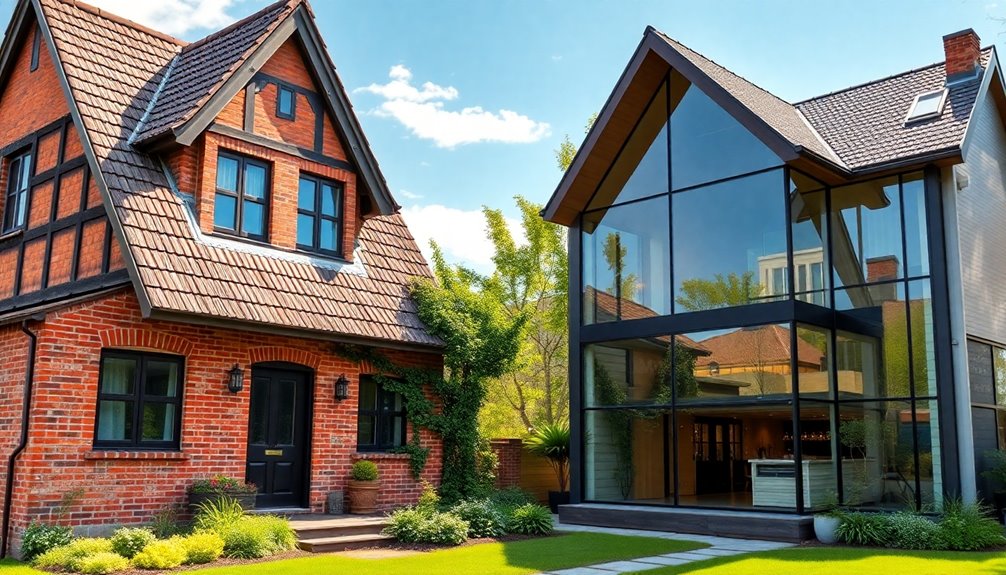
Modern homes stand out for their innovative designs that embrace open-concept floor plans, promoting a seamless flow between living spaces.
You'll love how large windows and skylights flood your home with natural light, creating a warm connection between indoors and outdoors.
The use of industrial materials like steel and glass emphasizes durability and sustainability, while minimal ornamentation and a neutral color palette maintain a clean aesthetic.
- Feel the freedom of open spaces.
- Experience the harmony of nature and design.
- Enjoy the convenience of smart home technology.
In modern homes, you'll find that every detail serves a purpose, allowing you to enjoy a stylish, efficient, and inviting environment that truly reflects contemporary living. Additionally, many modern homes draw inspiration from historic farmhouse architecture, blending traditional charm with modern functionality.
Key Differences in Design
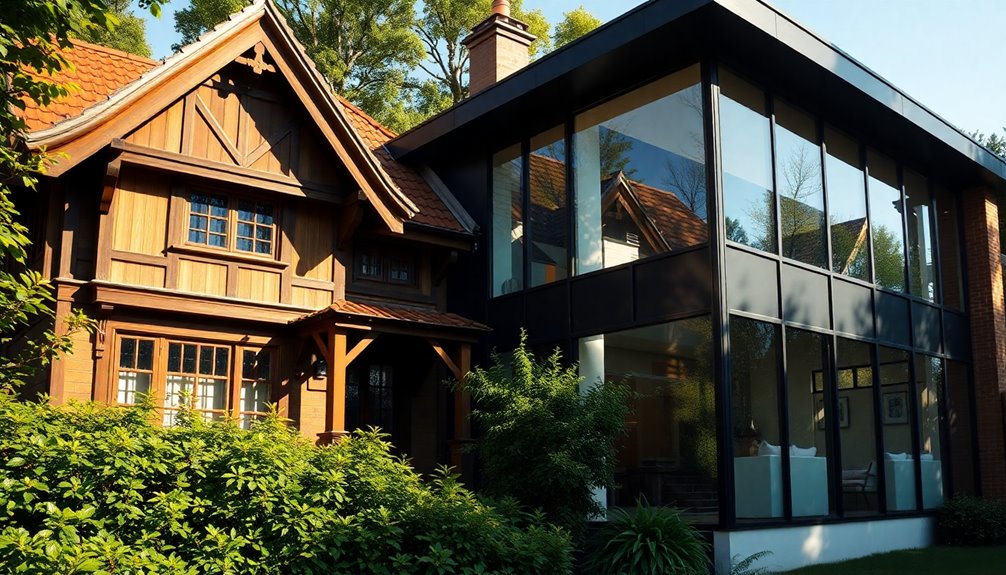
While both traditional and modern houses offer unique appeals, their design philosophies contrast sharply. Traditional architecture features ornate designs with gabled roofs and symmetrical windows, while modern design emphasizes sleek lines and minimal ornamentation. You'll notice traditional homes have compartmentalized floor plans, unlike the open-concept layouts in modern houses, which promote fluidity.
| Aspect | Traditional Architecture | Modern Design |
|---|---|---|
| Window Size | Smaller, decorative windows | Large, unadorned windows |
| Furniture Style | Ornate, dark wood furniture | Minimalist, neutral palettes |
| Building Materials | Brick, wood | Steel, concrete, glass |
These differences in architectural styles affect not just aesthetics but also the overall interior design and ambiance of the home.
Energy Efficiency Comparisons
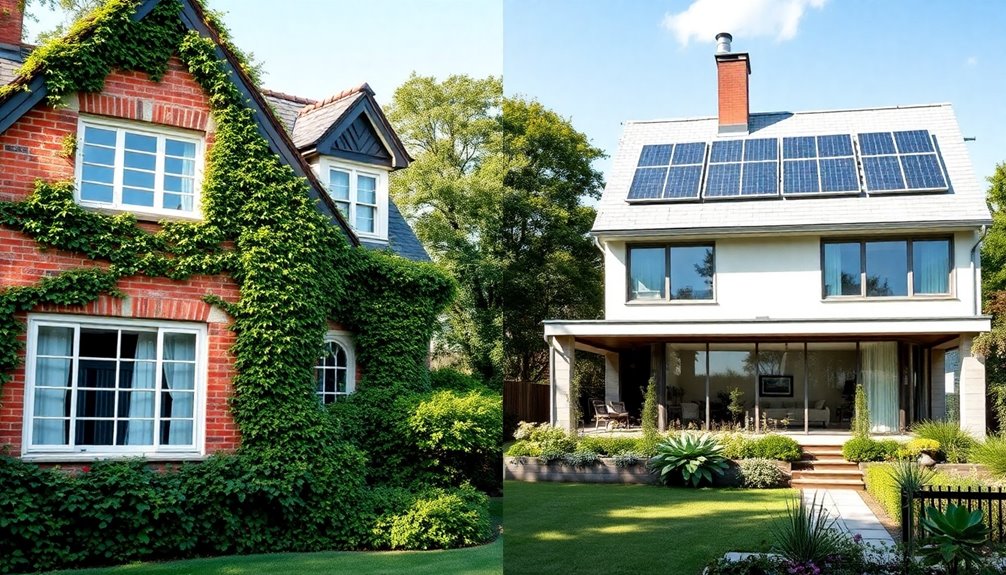
When you compare traditional and modern houses, energy efficiency stands out as a key difference.
Modern homes use advanced insulation techniques and energy-efficient appliances that help you save on utility bills.
Plus, the integration of renewable energy sources like solar panels makes modern designs not just eco-friendly but also cost-effective in the long run. Additionally, many modern homes incorporate heat pump technology, which enhances overall energy efficiency by utilizing renewable energy for heating and cooling.
Modern Insulation Techniques
As you explore the differences between traditional and modern houses, you'll find that modern insulation techniques greatly enhance energy efficiency.
These advanced methods, such as spray foam and rigid foam board, can cut energy consumption by up to 50%.
Modern homes often feature energy-efficient windows with double or triple glazing, lowering heating and cooling costs by 10-25%.
- Imagine cozy evenings without skyrocketing bills.
- Picture a home that stays comfortable year-round.
- Envision lower utility costs as you embrace smart home technology.
With continuous insulation systems eliminating thermal bridging, modern insulation guarantees consistent indoor temperatures.
In contrast, traditional homes may rely on outdated materials, leading to higher energy costs and increased heating demands. Additionally, the materials used in traditional Indonesian housing contribute to less effective insulation compared to modern techniques.
Energy-Efficient Appliances
Energy-efficient appliances play an essential role in modern homes, helping you save on utility bills and reduce your environmental footprint.
Compared to traditional homes, modern houses often incorporate energy-efficient appliances that consume up to 50% less energy. This significant reduction in energy consumption means you can enjoy savings of around $400 annually with Energy Star-rated appliances.
Advanced technologies like smart thermostats and energy-efficient refrigerators further enhance these savings, typically ranging from 10-30%.
In contrast, traditional homes frequently rely on older, less efficient models, leading to higher costs and environmental impact. Additionally, the use of HEPA filters in air purifiers within modern homes contributes to improved air quality, further enhancing the overall energy efficiency of living spaces.
Renewable Energy Integration
While modern homes embrace renewable energy integration, traditional houses often miss out on these advancements.
You'll find that modern materials, like advanced insulation and energy-efficient windows, greatly improve energy conservation. By utilizing renewable energy sources such as solar panels, modern homes can considerably reduce long-term energy costs and environmental impact.
In contrast, traditional homes rely on outdated techniques and older appliances that consume more energy.
- Imagine slashing your utility bills with smart home technology.
- Picture a cozy space that stays warm in winter without skyrocketing costs.
- Envision a future where your energy footprint is minimized for the planet's sake.
Additionally, modern heating solutions, such as heat pumps, provide enhanced energy efficiency and improved indoor air quality compared to traditional heating systems.
These features not only enhance comfort but also contribute to a sustainable lifestyle that traditional homes simply can't offer.
Cultural Significance of Styles

When you explore the cultural significance of architectural styles, you'll find that traditional houses serve as tangible links to local history and heritage.
Traditional architecture showcases unique design elements, like Victorian or Colonial styles, that resonate with community identity and celebrate craftsmanship. These homes preserve cultural heritage, connecting generations and telling stories of the past.
In contrast, modern architecture reflects societal progress with a focus on innovation, minimalism, and functionality. It often emphasizes sustainability and energy efficiency, addressing contemporary environmental concerns. The incorporation of natural materials in modern designs, such as wood and stone, creates a connection to the past while embracing current trends.
The coexistence of these styles in urban landscapes highlights a dynamic cultural dialogue, allowing you to appreciate both traditional craftsmanship and modern advancements, ensuring that your community embraces its rich history while moving towards a sustainable future.
Making Your Choice
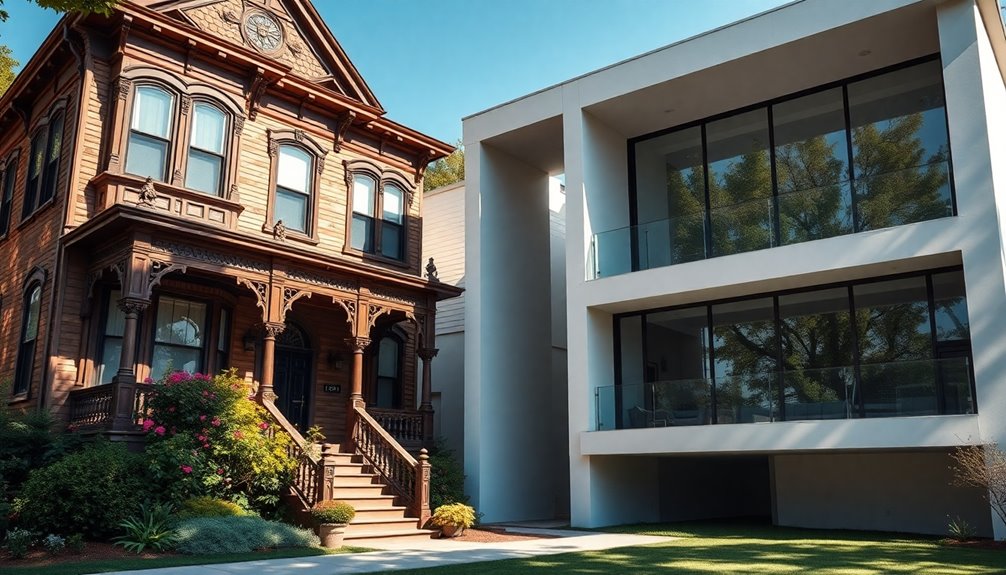
When you're deciding between a traditional and modern house, think about your lifestyle and what really resonates with you.
Do you prefer the charm of ornate details or the sleek lines of minimalism?
Your aesthetic preferences and values will shape your choice, so consider what feels like home to you. Additionally, understanding the impact of environmental factors on your living space can also influence your decision.
Personal Lifestyle Considerations
Choosing between a traditional and modern house often hinges on your personal lifestyle needs.
Traditional homes with ornate craftsmanship and historical significance offer cozy, intimate spaces, perfect for hosting family gatherings. In contrast, modern houses prioritize energy efficiency and open-concept layouts, designed for flexibility and contemporary living.
- Feel the warmth of traditional design elements that tell a story.
- Embrace the sleek, innovative materials that define modern kitchens.
- Find a community that resonates with your values and lifestyle.
Consider what suits your personal style—whether it's the charm of nostalgia or the allure of minimalism.
Think about your community characteristics, too; does it lean more towards cultural heritage or modern amenities? Your choice reflects who you are. Additionally, assessing how a home fits into your work-life balance is crucial, as a flexible work environment can significantly enhance your lifestyle.
Aesthetic Preferences and Values
While considering your aesthetic preferences, it's imperative to recognize how they influence your choice between traditional and modern houses. Traditional styles often showcase intricate craftsmanship and rich textures, appealing to those who cherish history and nostalgia. Modern architecture, on the other hand, emphasizes minimalism and functionality, attracting individuals who value sustainability and contemporary living.
| Traditional Style | Modern Architecture |
|---|---|
| Ornate detailing | Clean lines |
| Historical elements | Industrial materials |
| Emphasis on craftsmanship | Focus on functionality |
| Rich textures | Sustainable design |
Ultimately, your decision hinges on personal values and lifestyle needs. Whether you lean towards historical charm or modern convenience, understanding these aesthetic differences will guide your design process effectively.
Frequently Asked Questions
What Are the Differences Between Traditional and Modern Houses?
When you explore the differences between traditional and modern houses, you'll notice that traditional homes emphasize ornate designs and historical details, while modern ones focus on minimalism and functionality.
You'll find traditional houses often feature compartmentalized rooms and rich materials like wood and brick. In contrast, modern homes boast open layouts with industrial materials like glass and steel.
Additionally, traditional furnishings are typically ornate, whereas modern pieces lean towards simplicity and neutral colors.
What Is the Difference Between Old House and Modern House?
When you compare old houses to modern ones, you'll notice several key differences.
Old houses often feature intricate designs and smaller rooms, while modern houses embrace open layouts and minimalist aesthetics.
Materials also vary; older homes typically use wood and brick, whereas modern builds incorporate glass and steel for a sleek look.
Additionally, modern houses usually include smart technology, enhancing convenience and efficiency, while old homes reflect a unique historical charm and craftsmanship.
What Are the Differences Between Modern Buildings and Traditional Buildings?
You might think all buildings serve the same purpose, but modern and traditional buildings differ considerably in style and function.
Modern buildings embrace minimalism, utilizing open layouts and large windows to let in natural light. You'll notice they often incorporate industrial materials like steel and glass.
In contrast, traditional buildings showcase intricate designs with compartmentalized rooms, focusing on craftsmanship and warmth.
Each style reflects different values and lifestyles, shaping how you experience your environment.
What Is the Difference Between Old House and New House?
When you compare old houses to new ones, you'll notice distinct differences.
Old houses often showcase intricate designs and durable materials, reflecting historical styles. In contrast, new houses focus on simplicity and functionality, featuring open floor plans and large windows.
You might find that energy efficiency is better in newer homes due to modern technology, while older homes may require updates to improve their performance.
Each type has its charm and practical advantages.
Conclusion
In choosing between traditional and modern homes, remember that nearly 60% of homebuyers prefer modern designs for their energy efficiency and open spaces. This preference highlights the shift towards sustainability and minimalism in today's housing market. Whether you lean towards the classic charm of traditional homes or the sleek lines of modern architecture, it's crucial to reflect on what fits your lifestyle. Ultimately, your choice reflects your values and vision for a comfortable living space.
